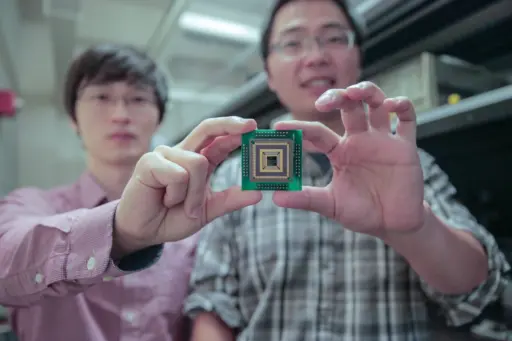Drawing inspiration from the directional hearing abilities of geckos, a multi-institution team led by engineers at the University of Wisconsin-Madison has created first-of-their-kind high-resolution sensors that can deduce the angle of incoming light beams.
It’s an advance that could help autonomous vehicles navigate roads and avoid hazards or unlock a whole host of capabilities for cameras and telescopes by giving their photodetectors access to information about the direction of light.
 Soongyu Yi (left) and Ming Zhou (right) holding a gecko-inspired photodetector that senses the angle of incoming light.
Soongyu Yi (left) and Ming Zhou (right) holding a gecko-inspired photodetector that senses the angle of incoming light.
“Conventional photodetectors can only detect the intensity of light, but there are many more properties,” says Soongyu Yi, a PhD student, who works in Assistant Professor Zongfu Yu’s lab in the UW-Madison Department of Electrical and Computer Engineering. Yi was first author on a paper describing the new devices, published Oct. 29, 2018, in the journal Nature Nanotechnology.
With information about the angle of incoming light, cameras can more accurately measure the distance to objects in an image. That artificial depth perception could, for example, help self-driving cars avoid obstacles.
Other groups have attempted to create photodetectors that can glean information about depth, but those previous attempts suffered from low resolution, with pixel sizes much larger than the wavelengths of the light they captured.
Yi and colleagues were able to create photodetectors that resolved pixels smaller than the wavelength of light. To do so, they turned their eyes to the ears of small animals like geckos, crickets and mice.
Those tiny critters share an ability called directional hearing—and the way they determine where sound is coming from differs from how larger creatures like rabbits and people accomplish that feat.
Big animals—or those with heads wider than the wavelength of sound—perceive a tiny time delay between when each of their individual ears picks up a noise. That allows them to determine the direction from which the sound originated.
Small animals can’t rely on that time-lag. Instead, many creatures—geckos and crickets included—have a tunnel inside their head that links their two ears. Sound waves traveling back and forth through the tunnel create a new signal that allows the animals to determine the sound’s direction. It’s an adaptation found in more than 15,000 species.
The researchers realized a similar strategy could allow them to detect the angle of incoming light, so they created special photodetectors consisting of two tiny, optically linked wires.
“Each wire absorbs and scatters light, and the scattered light interacts with the other wire,” says Ming Zhou, a UW-Madison electrical and computer engineering PhD student who was second author on the paper.
Just like water ripples bouncing between two vertical pilings in a lake or sound traveling through the tunnel in a gecko’s skull, light waves scatter between the two nanowires in the new photodetectors. Combining that scattered light with signals from each individual nanowire allows the researchers to calculate the light’s direction.
“It’s two photodetectors working together, electrically separate from each other, but optically coupled. That gives us the physics,” says Zhou.
Currently, the researchers’ sensors capture only single pixels, but they are working to create arrays of the new photodetectors that are capable of analyzing larger images. They’re also developing strategies to ensure the new photodetectors can integrate seamlessly with existing cameras.
And they plan to use the concept to measure additional properties of light, such as wavelength. Such spectral information could enable cameras or telescopes to analyze properties ranging from the geological composition of a distant comet to the freshness of produce at a grocery store.
“It’s all about information,” says Zhou. “You want to know the exact 3D location of an object, and you want to read the spectrum.”
Other members of the team include Zongfu Yu, the Dugald C. Jackson Assistant Professor of electrical and computer engineering at UW-Madison. Mark Brongserma, a professor of materials science and engineering , Shanhui Fan, a professor of electrical engineering, both at Stanford University; Nader Behdad, a professor of electrical and computer engineering at UW-Madison; and Pengyu Fan, Dianmin Lin and Ken Xingze Wang of Stanford. The work at the University of Wisconsin was funded by the Office of Naval Research (N00014-14-1-0300). The work at Stanford was supported by a Multi University Research Initiative (MURIs FA9550-14-1-0389) and an individual investigator grant (FA9550-17-1-0331) from the AFOSR.